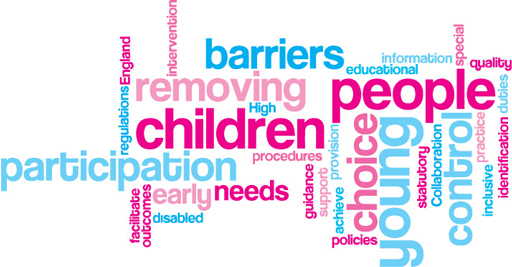Special needs
Introduction

This is a general introduction to the area of children with special educational needs and/or disability (SEND). The most prominent words in the Wordle image – participation, making choices, taking control and the removal of barriers – are important considerations for supporting children with SEND and these concepts underpin this section.
Many teaching assistants are employed to support children with SEND as a one-to-one, or in a specialist support role. So you will be considering how to support children with SEND through their primary and secondary schooling. This section aims to develop your understanding of what SEND encompasses, what support there is for children with SEND, and what the challenges are for such children.
This subject has been divided into three topics:
- What does SEND mean? considers what we mean by the terminology and policy relating to SEND.
- Victimisation and bullying focuses on the support children might need if they come to school with a particular ‘diagnosis’ or label. What does legislation and policy tell us about how we should be supporting children, and what does policy look like in practice?
- Supporting a child with SEND focuses on the role of the teaching assistant in supporting children with SEND. However, no one is an expert in everything, so we also consider what you can do if you are feeling out of your depth.
A note about terminology:
The Children and Families Act 2014 clarified the scope of support from earlier legislation, which only referred to children and young people with special educational needs (SEN), to specifically include children and young people with disabilities by using the term SEN in policy documentation. However, this change in terminology is not reflected in pre-existing documentation and so, as you work through the material, you will come across the term SEN.
